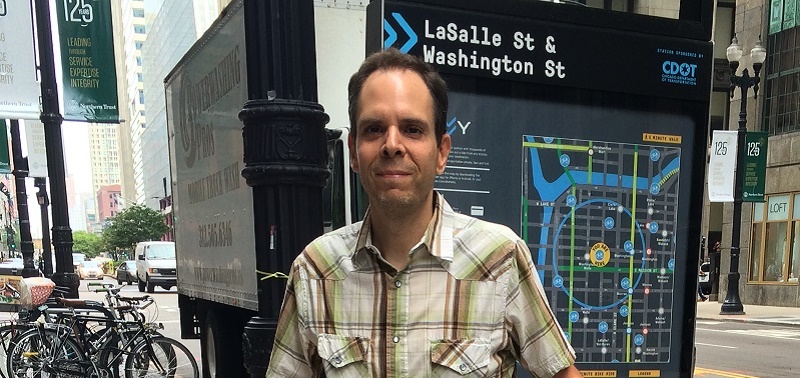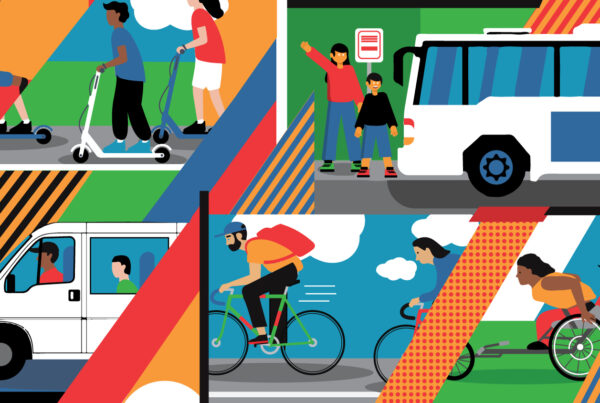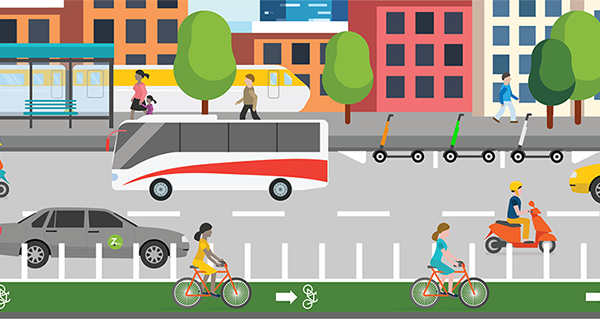Chicago’s Divvy bikeshare is the largest system in North America in terms of geographic service area, with plans to continue expansion in 2016, including to the neighboring suburban communities of Oak Park and Evanston. Last year, the City also launched the “Divvy for Everyone” program to expand access to low-income residents by offering discounted year-long memberships and cash payment options. The man behind much of that progress is Chicago Department of Transportation Assistant Commissioner Sean Wiedel who, in addition to managing Divvy, has played a key role in stewarding the growth of the bikeshare industry through his work on NACTO’s Bike Share Working Group and the North American Bikeshare Association’s (NABSA) board of directors.
The following is a lightly edited version of the Shared-Use Mobility Center’s conversation with Mr. Wiedel.
What’s does the future look like for Divvy?
We’re going to be expanding Divvy’s presence significantly this year, including out to Oak Park on the City’s west side and Evanston on the north side. In all, our short term expansion plan is to add at least 55 stations within the city and 20 suburban stations, but we’re also working to find additional funding from the Congestion Mitigation and Air Quality Improvement (CMAQ) program and other sources. We’re not planning on stopping. All told it will probably take us five or more years to complete the network.
Other issues we’re looking into include helmet vending machines and smartphone apps or other means to ensure better integration between bikeshare and other modes of public transit. Another holy grail when it comes to ridership is finding a way for people who have Divvy memberships to be able to use bikeshare systems in other cities across the country.
What are you doing now to help Divvy integrate with other forms of transit?
In the first half of 2016, we’ll be integrating Divvy more fully into Transit App’s mobile app. Ultimately, members and visitors will be able to purchase 24-hours passes and use their memberships without having to go to the kiosk at the Divvy station. We have also done some promotional work with Metra and the Regional Transportation Authority (RTA) to get Divvy’s stations included on transit maps, and are currently working with the Chicago Transit Authority (CTA) on that as well. Half the battle is just getting people to realize that bikeshare is an option. We’ve developed Divvy for short trips, so it is the perfect first/last mile solution to get people to and from transit. People ask on regular basis if we’ve thought about changing the 30-minute time limit on each ride. We haven’t because we want the bikes to remain in circulation.
In our user surveys each year, many people self-report that they’re actually used transit more and driven less since they joined Divvy. Hopefully over the long term that will lead to fewer car trips, less use of our roads and a better, more sustainable city for everyone.
How has Chicago’s Divvy for Everyone program been working?
One challenge we wanted to address in Chicago is the issue of providing bikeshare to the unbanked and low-income communities. The way most systems are set up currently, you need a debit or credit card to rent a bike. With Divvy for Everyone (D4E), we partnered with the Local Initiatives Support Corporation – Chicago (LISC) to create a cash payment system. People can visit one of LISC’s five financial opportunity centers to sign up for a discounted $5 yearly Divvy membership. You just need to bring your ID and a pay stub, or sign an affidavit saying you don’t have any income, and you can walk out with a Divvy key that same day.
Because we realized we couldn’t keep giving someone access year after year for only $5, D4E is currently a one-year program. However, we’re working on a number of options to keep people signed on in the second year. LISC has a credit building program, and we’re hoping some D4E users will take advantage of that to improve their situation. We’re also developing a cash payment option to roll out later this year. Once people see the opportunity of Divvy in their lives, we hope they’ll want to stay on.
Another key part of the program is the community ambassadors, who are doing a lot of education and outreach in neighborhoods across the city. We’ve had events in neighborhoods like Bronzeville, Pilsen and Uptown to get residents to recognize that Divvy is for them. We need to get people in new communities to understand that Divvy was built with them in mind.
How else has Divvy been addressing equity issues?
We have been working on equity in a number of ways. While there are still people who have concerns the Divvy is not serving the entire city, we have expanded it at the same rate both north and south, with equal station density in every neighborhood so you never have to walk more than half a mile to get to a dock. The thing people need to understand is that bike share needs to be a network. We can’t just have pods out on the perimeters. We want people to be moving the bikes, not a Divvy van.
We have also made it a priority to hire a diverse workforce. We work with Greencorps Chicago – CDOT’s green industry job training program for individuals with barriers to employment – as well as a group called Skills for Chicagoland’s Future. We also partner with the Greencorps Youth program, which provides summer jobs for at-risk Chicago Public School students. For the youth, we provide a six-week training program on bike safety and bike mechanic skills, and have hired on some students permanently. In all we have a wide range of positions – including rebalancing and dispatch workers, bike checkers and mechanics – that are filled from those programs. At the end of that day it’s really about making Chicago a better place for everyone. That’s what interests me.
What changes do you see ahead for the bikesharing industry?
There are a number of emerging trends and technologies to watch. While Divvy is a station-centric model, there are other cities that experimenting with systems where the tech is located in the bike. Some systems are also thinking about electric bikes and how to tackle issues like power management.
It’s still a young industry, and we’ll probably see more shakeout and change in things like equipment ownership, funding and sponsorship models and pricing structures. It’s a grand experiment. We’re still trying to figure out the right model. What’s that funding package – including operational, sponsorship, advertising dollars – that makes a system sustainable? I don’t think anyone has the answer yet.
In my role on the NABSA board of directors, I hope to help influence the direction and growth of the bikeshare industry across the country. We have a robust board representing cities, non-profits and for profit owners and operators from across the U.S. and Canada. We’re all engaged in making bikeshare better and ubiquitous.
Do you have a favorite Divvy ride?
We launched Divvy on June 28, 2013. My wife had never taken her bike out in Chicago, but I convinced her to ride Divvy downtown that weekend. It was a great day, not a lot of traffic, and we had a lot of fun riding around to about 20 different stations to check how they were working. Now my wife will ride Divvy with me everywhere. It really is the best gateway drug to cycling.
What are your hobbies outside transportation?
I’m a big movie buff. One of my all-time favorites is Magnolia, I love Paul Thomas Anderson. I also really enjoy quirky dramas. There are a lot of interesting TV shows coming out of Europe – Danish, English, Nordic, Swedish – and my hobby is seeking them out. A few favorites are the Swedish/Danish crime series The Bridge and Borgen, a fictional account about Denmark’s first woman prime minister.



